Last Updated on April 4, 2024
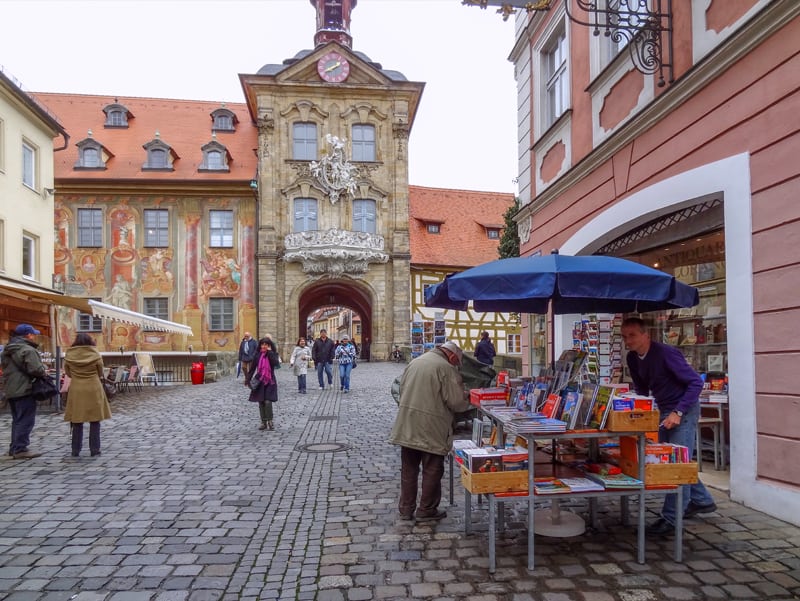
By Jim Ferri
Bamberg is a beautiful Bavarian city, a natural stop for the many river-cruise ships sailing through Germany. It’s also a great day trip from Munich.
That’s how I first visited Bamberg, on a cruise that had departed Vienna and was en route to Amsterdam. It was a wonderful and relaxing trip.
When we reached Bamberg, however, I was a bit taken aback.
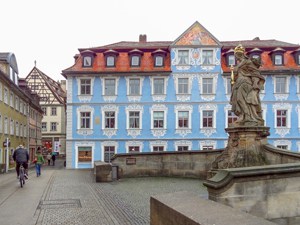
I hadn’t really expected a Bavarian River town to be so interesting and captivating. And colorful.
Bamberg is also a stunning small German city, with one of Europe’s largest fully intact old-town centers and many things to do. And, somehow, it has managed to retain its medieval beauty through many centuries. Those centuries have included several regional wars, the Black Plague, and World War II. It’s really an incredible little city and also a great day trip from Munich.
Most fittingly, UNESCO has added the city to its World Heritage list, citing Bamberg as an “outstanding and representative example of an early medieval town in central Europe.” I found it fascinating that, according to the UNESCO citation, “from the 12th century onward, the architecture of Bamberg strongly influenced northern Germany and Hungary.”
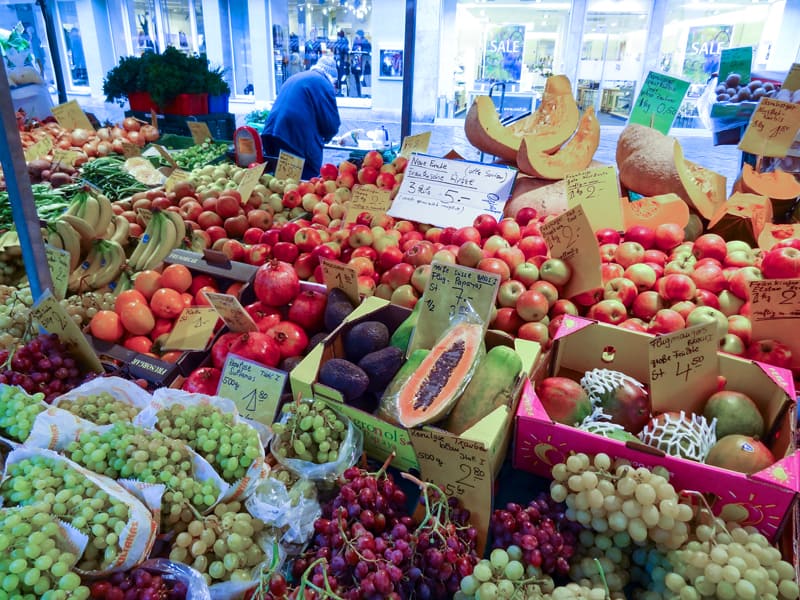
Breakfast, Then a Walk to the Market
As it often did, our ship had quietly sailed to a new town during the night. We were now moored near the Old Town in Bamberg, right in the heart of all we wanted to see.
You’ll quickly discover it’s one of the benefits of river cruising. Get off the ship, see the town, get back aboard for lunch or dinner. Have a drink, go to bed, wake up in a new place. No packing and unpacking and feeling pampered. Feeling pampered was especially good.
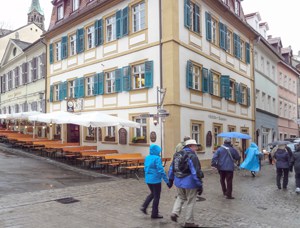
Following breakfast, I joined our onboard ship guide and our little group on the dock. A light rain was falling every now and then, and would continue through most of the day, but no one seemed to mind.
Once we were all gathered, we walked a few short blocks across the bridge to the Obstmarkt (Fruit Market). It was a colorful green market held six days a week, which spreads out around a statue of Neptune. It’s primarily a fruit and food market with a few non-food stands.
We all wandered about the market for a half-hour or so before regrouping to cross back over the river to Old Town Bamberg. First, though, we headed across the nearby Langestrasse, along which there are several pastry and food shops. I would have ducked into a few if we hadn’t so recently finished breakfast.
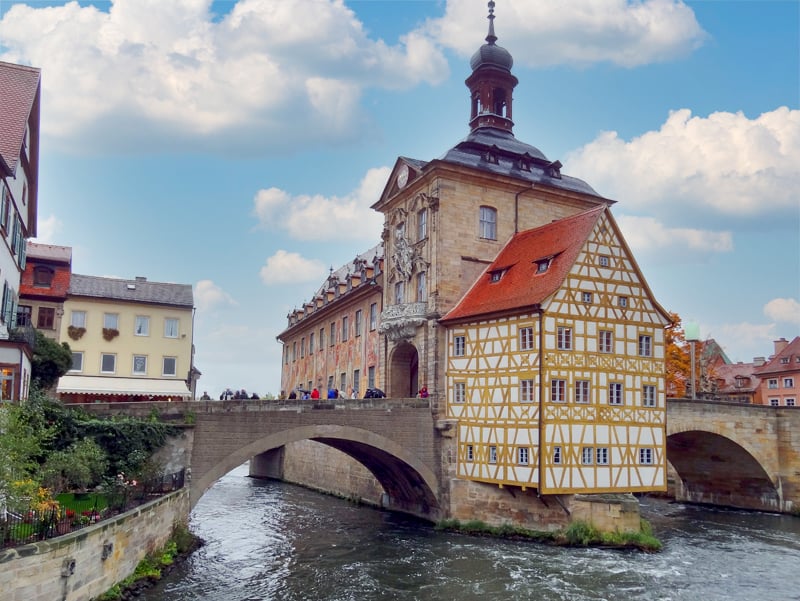
Altes Rathaus
Two bridges – the Untere Brücke and the Obere Brücke – join Bamberg’s Old Town with the area across the river. Once over the bridge, we headed for the Altes Rathaus, the old town hall, which sits on an island in the middle of the river. Given its beautiful exterior and scenic location, it’s likely the most photographed building in town.
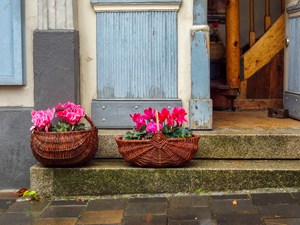
From Untere Brücke, the lower bridge, there’s a great view of Obere Brücke, the upper bridge. Obere Brücke is the site of Bamberg’s beautiful and much-photographed town hall (the Rathaus, as it’s called in German). The Rathaus also has half-timbered structure (the Rottmeisterhaus) jutting out from the building’s downstream side. It was added in 1688 and appears to be floating above the water.
Don’t, however, put your camera away after the Altes Rathaus. There are many original buildings from the Middle Ages to the Baroque era in Bamberg that provide plenty of photo fodder. In fact, just around almost every corner, you’ll find something intriguing. I found it fascinating just walking about looking at the old timbered houses.
Bamberg has über color, from pastel buildings lining little lanes to the blazing red geraniums tumbling out of window boxes. It all seems like old Germany at its finest, especially if you walk along the cobbled streets in Bamberg’s old town, which encompasses 3200 buildings.
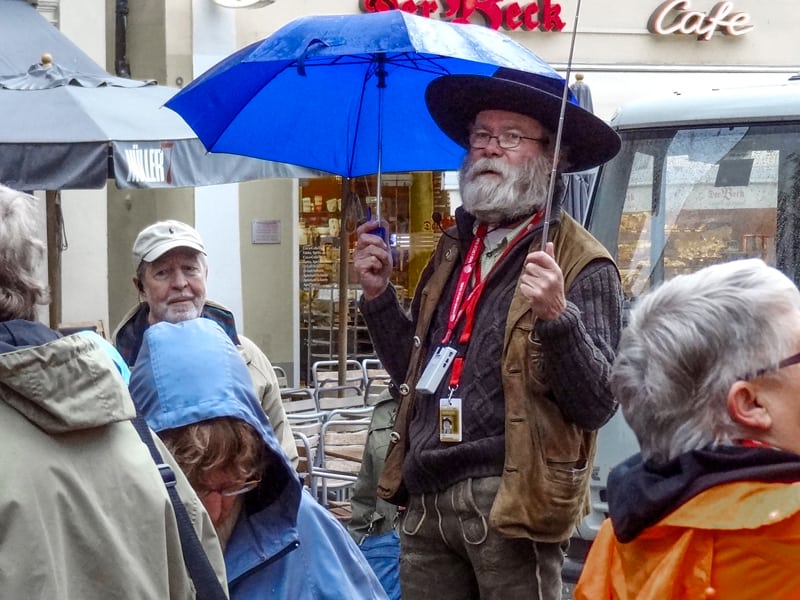
Our Guide in Lederhosen
Beyond the Altes Rathaus, we walked up Karolinenstrasse, where we met the local guide hired by our ship. It was a fall day, and, despite the occasional rain and intermittent gusts of wind, he was dressed in lederhosen. A proud Bavarian, I thought.
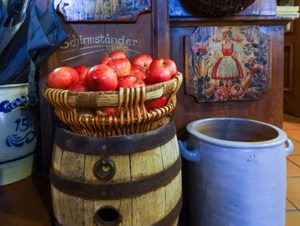
He immediately collected us, and we started walking towards Bamberg Cathedral, one of the city’s focal points. Along the way, he told us about three famous Bambergers who had emigrated to the U.S. from Bamberg. One was Levi Straus, of Levi jeans fame. If Levi Straus wasn’t enough, the others were two brothers named Lehman, who founded the financial services firm Lehman Brothers in New York.
Adding to the potpourri of local lure, he also boasted that Bamberg has one of the top basketball teams in Germany, thanks to American GIs who introduced the sport here.
But what makes Bamberg really fascinating, he told us, is that Bamberg was significant even back in Roman times. He said Bamberger’s then bragged about it being as important as Rome, citing that their city also had seven hills. “The truth is,” he confided, “the city only has six hills. Bambergers cheated by naming one hill twice by giving a different name to each side.” I haven’t ever, however, been able to authenticate his story.
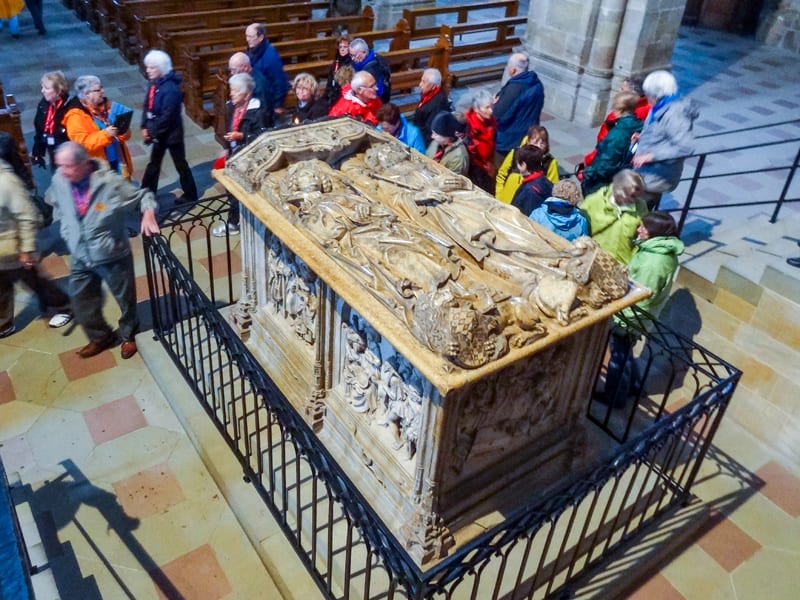
Bamberg’s Domplatz and the Cathedral
The Domplatz (Cathedral Square) in Bamberg is considered one of the finest in Germany, and it measures up to its reputation. One of the most famous historic sites in the city, the Cathedral has three naves, two choirs, and four towering steeples. It was first consecrated in the 11th century, destroyed by fire in the 13th and rebuilt in the 15th. Architecturally, the Cathedral is a combination of late-Romanesque and early French-Gothic styles due to the length of time to rebuild it.
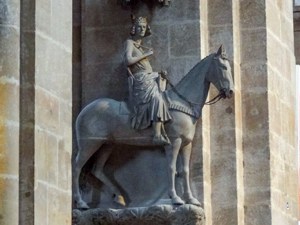
But it’s the interior that is of most interest. In the western choir of the church, you’ll find the grave of Pope Clement II. Clement had once been the Bishop of Bamberg but then died after being Pope for only nine months. Near the beautifully carved Marian altar, it’s the only papal tomb outside of Italy and France.
On the eastern side of the Cathedral is the tomb of Holy Roman Emperor Henry II, who order the building of the Cathedral. He is the only medieval German monarch to ever have been honored as a saint. His wife, Empress Cunigunde of Luxembourg, who was also sainted, is interred with him.
However, the most famous statue in the church is the “Bamberg Rider” (Bamberger Reiter), dating from the mid-13th century. For centuries, the man on horseback has puzzled scholars about his identity, prompting conjecture from scholars and tour guides. However, some scholars have recently concurred that the rider is most likely the Hungarian King Stephen I.
The Cathedral is also well-known for its traditional and modern religious art.
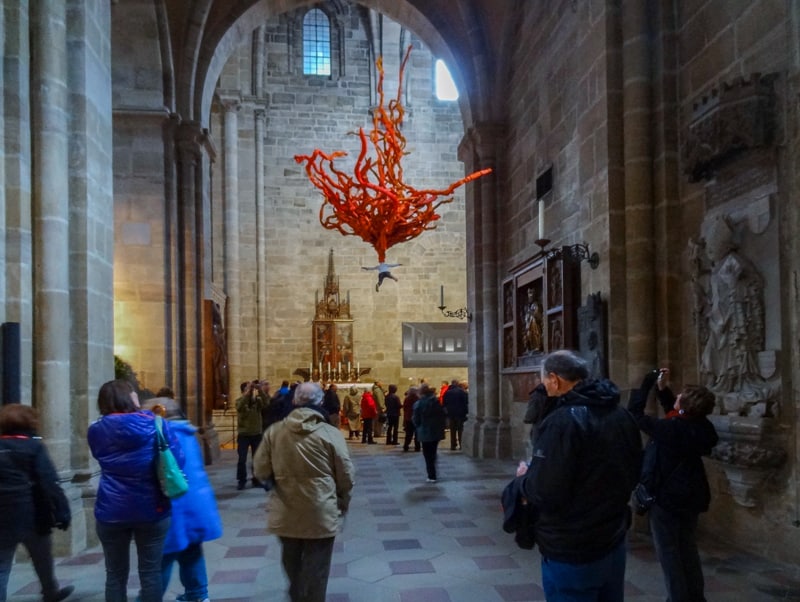
Other Highlights of the Domplatz
Historic buildings on the Domplatz also include the New Residence (Neue Residenz und Staatgalerie), which has a richly decorated interior. It has a collection of old German masters as well as 16 statues representing the Emperors of the Holy Roman Empire.
On its west side is the Alte Hofhaltung Historisches Museum Bamberg, in the former bishop’s residence. The former residence of the Bishop, it is famous for its portal with its statues of Heinrich II and Cunigunde. Built in the early 16th century, its focus is on the region’s history.
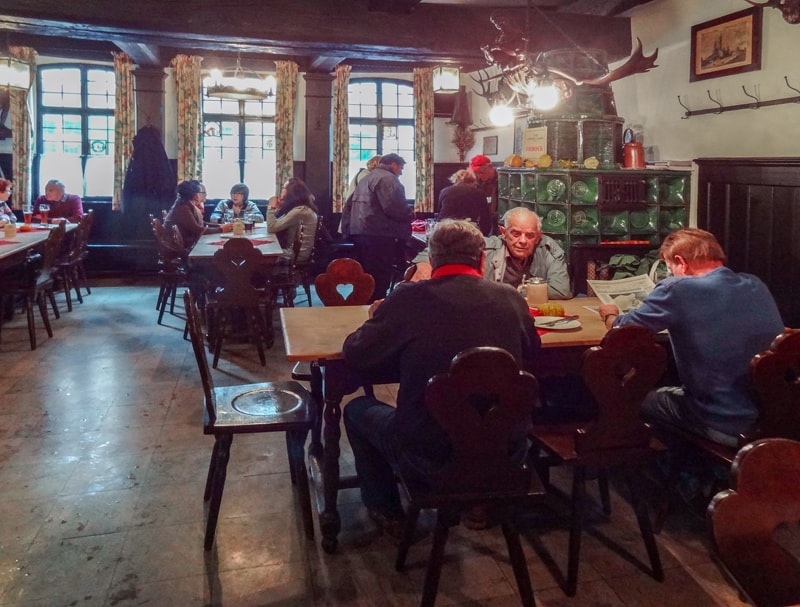
Bamberg’s Beer Culture
Although Bamberg has a population of only approximately 77,000, the city has nine breweries. In addition, there are another 75 within 25 miles of the city. Obviously, people here like their beer.
I couldn’t help noticing the numerous old craft signs hanging in front of several shops in Old Town. Several seemed to be the Star of David, the Jewish symbol. It seemed odd until we learned that in Franconia, this area of Bavaria, it’s the symbol for a brewery.
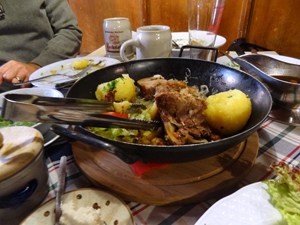
In fact, it’s something that many in Germany outside the Bamberg area don’t even realize. Since there are many breweries, we saw many of the signs along the main streets of the old town.
Bamberg is well known for rauchbier, a smoked beer with a unique smoky taste. I didn’t like it that much and preferred the standard local types, although others I was with enjoyed it.
I guess it’s all a matter of taste, just like the city’s local delicacy, a stuffed onion.
If you’re looking for a stuffed onion, Rauchbier, or traditional Franconian food, you’ll find many good restaurants that cater to your palate. Numerous restaurants in the old city serve traditional Franconian food, and plenty of shops cater to tourists’ interests.
You may also enjoy: Best German Towns to Visit on a River Cruise / Beautiful German Towns Worth Visiting (Video) / 6 Great Places to Visit in Bavaria / Day Trips From Munich to 3 Great Bavarian River Towns

Leave a Reply